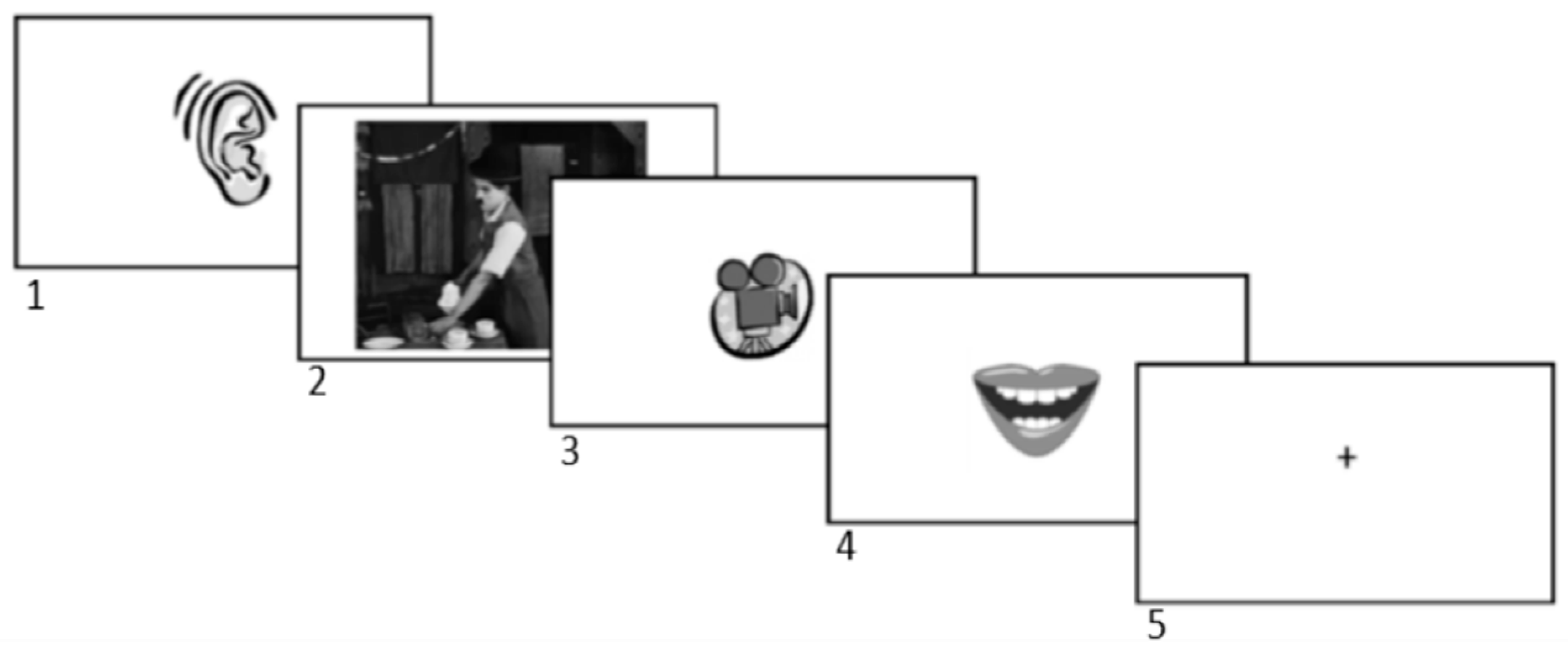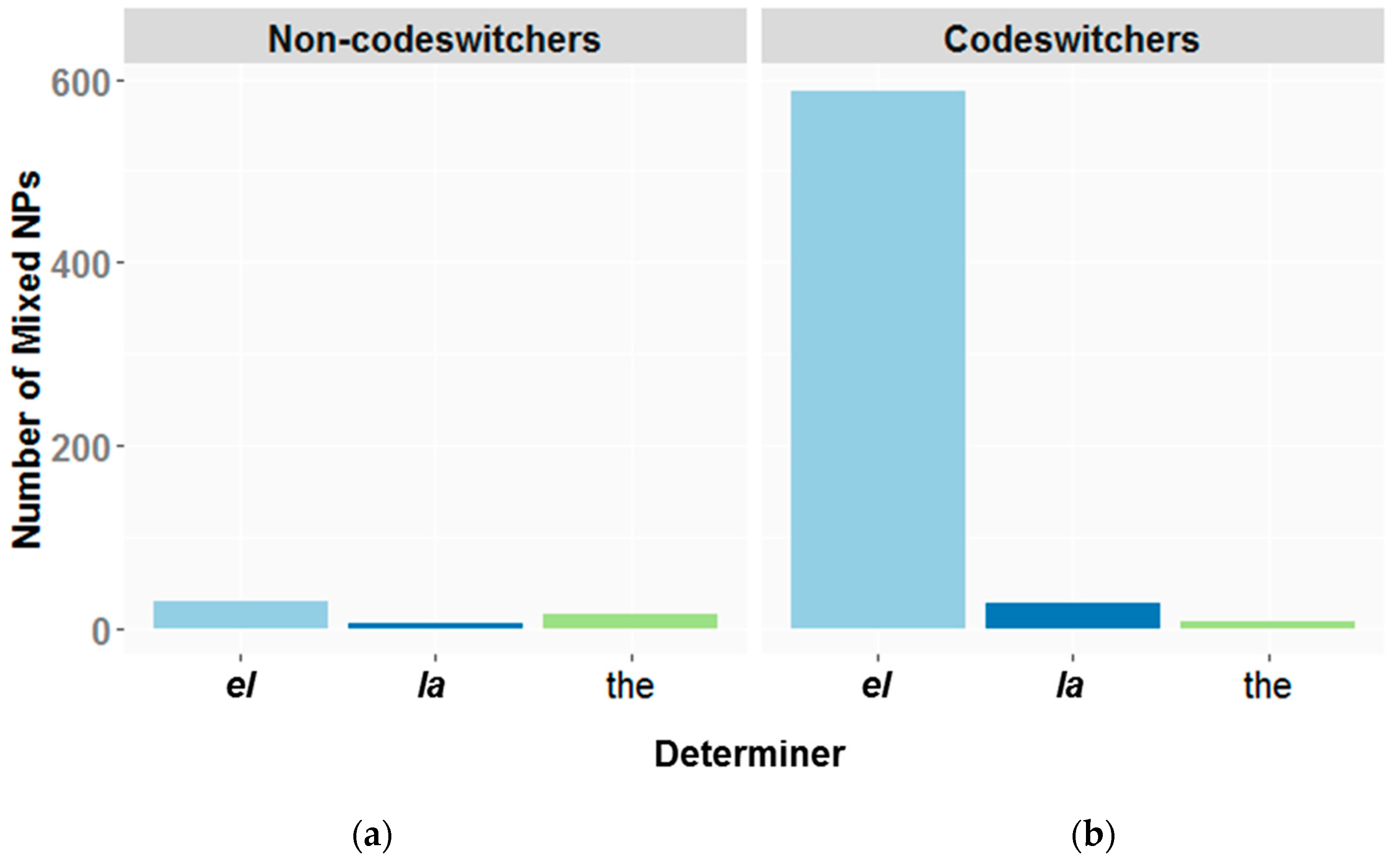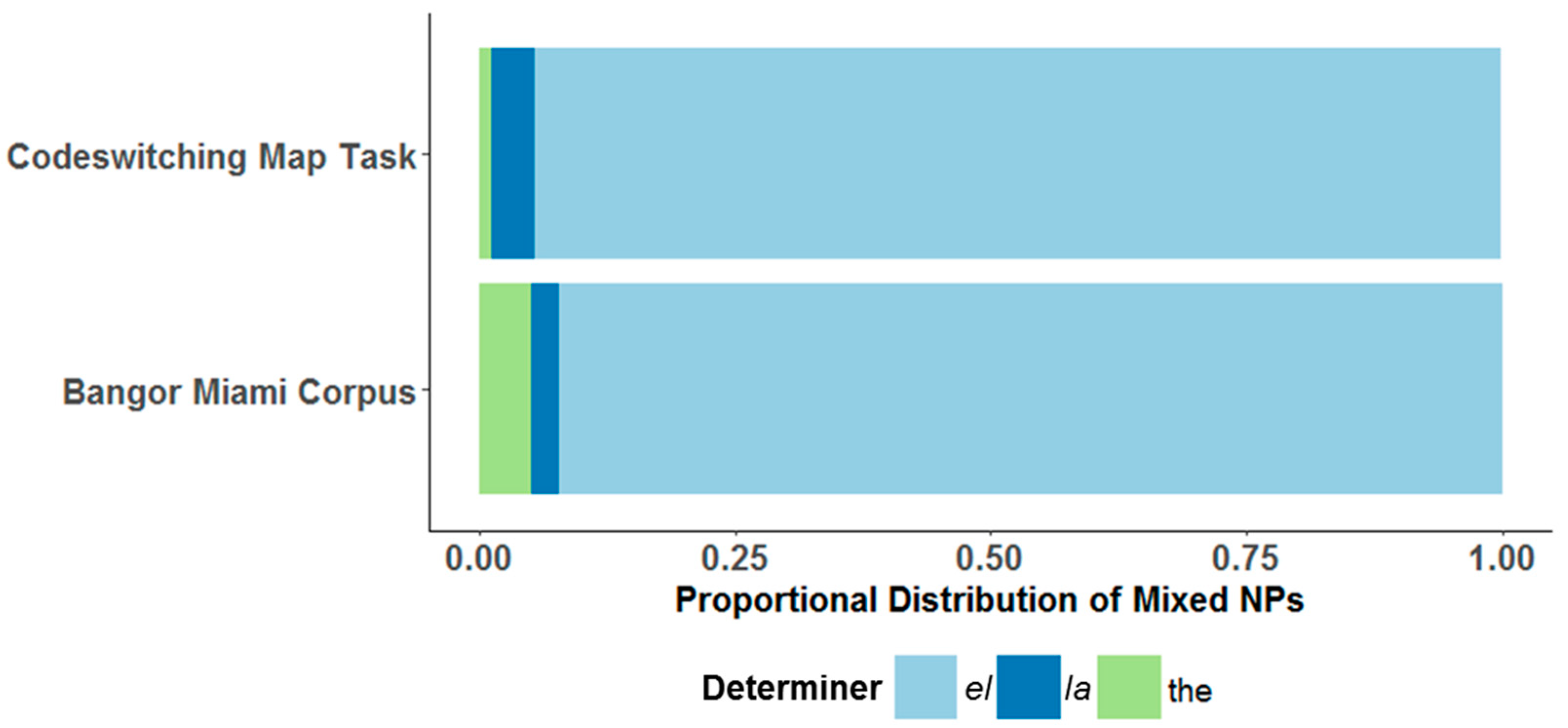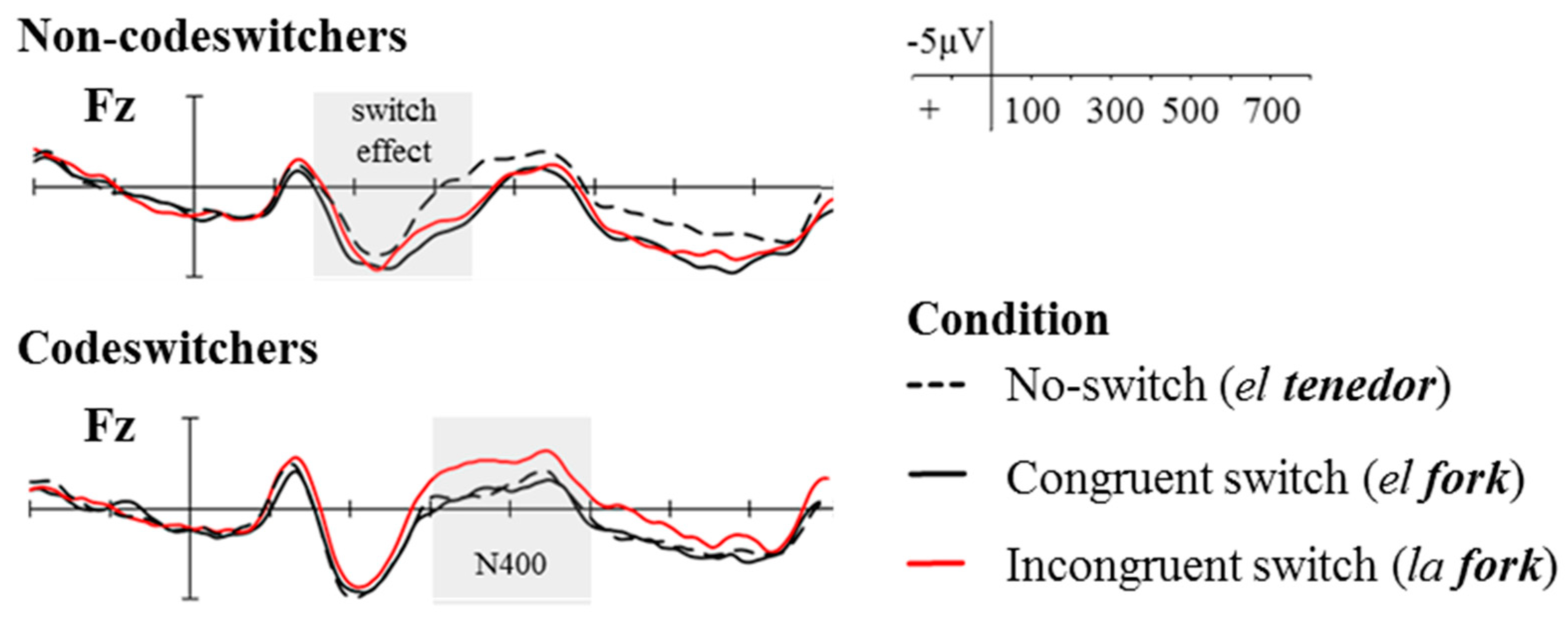From the Field to the Lab: A Converging Methods Approach to the Study of Codeswitching
Abstract
1. Introduction
1.1. Current Limitations and Methodological Challenges in the Study of Codeswitching
| 1. | I went to the store to buy some | manzanas |
| apples |
1.2. Roadmap
2. Corpus-Based Analysis of Codeswitching
2.1. Asymmetries in Verb Phrases
| 2. | los actores están | rehearsing their lines |
| the actors are |
| 3. | los actores han | rehearsed their lines |
| the actors have |
| 4. | los actors | have rehearsed their lines |
| the actors |
2.2. Asymmetries in Mixed-Noun Phrases
2.3. Accounting for Codeswitching Distributions
3. Codeswitching Assessment Tasks
3.1. Speech Elicitation Tasks
3.2. Other Methodological Considerations
4. Experimental Contributions of Eye-Tracking and Event-Related Potential Methodologies to the Psycholinguistic Study of Codeswitching
| 5. | he wanted to deposit all of his | dinero | at the credit union |
| money |
4.1. Eye-Tracking Contributions to Mixed Verb and Noun Alternations
| 6. | Los turistas están | enjoying their stay at the hotel |
| The tourists are |
| 7. | Los turistas han | enjoyed their stay at the hotel | |
| The tourists have | |||
4.2. Electrophysiological Sensitivity to Codeswitching Patterns
| 8. | La niña dijo que | the puppy wanted a treat | |
| The girl said that | |||
| 9. | La niña dijo | that the puppy wanted a treat | |
| The girl said | |||
5. Concluding Remarks
Author Contributions
Funding
Acknowledgments
Conflicts of Interest
References
- Adamou, Evangelia, and Xingjia Rachel Shen. 2017. There are no language switching costs when codeswitching is frequent. International Journal of Bilingualism, 1–18. [Google Scholar] [CrossRef]
- Altarriba, Jeanette, Judith F. Kroll, Alexandra Sholl, and Keith Rayner. 1996. The influence of lexical and conceptual constraints on reading mixed-language sentences: Evidence from eye fixations and naming times. Memory & Cognition 24: 477–92. [Google Scholar]
- Altmann, Gerry T. M. 2011. The mediation of eye movements by spoken language. In The Oxford Handbook of Eye Movements. Edited by Simon P. Liversedge, Iain D. Gilchrist and Stefan Everling. Oxford: Oxford University Press, pp. 979–1004. [Google Scholar]
- Balam, Osmer, and Ana de Prada Pérez. 2016. On the productive use of ‘Hacer+ V’ in Northern Belize bilingual/trilingual code-switching. In Spanish-English Codeswitching in the Caribbean and the US. Edited by Rosa E. Guzzardo Tamargo, Catherine M. Mazak and M. Carmen Parafita Couto. Amsterdam: John Benjamins, pp. 261–79. [Google Scholar]
- Beatty-Martínez, Anne L., and Paola E. Dussias. 2017. Bilingual experience shapes language processing: Evidence from codeswitching. Journal of Memory and Language 95: 173–89. [Google Scholar] [CrossRef]
- Bills, Garland D., and Neddy A. Vigil. 2008. The Spanish Language of New Mexico and Southern Colorado: A Linguistic Atlas. Albuquerque: University of New Mexico Press. [Google Scholar]
- Blanco-Elorrieta, Esti, and Liina Pylkkännen. 2017. Bilingual language switching in the laboratory versus in the wild: The spatiotemporal dynamics of adaptive language control. Journal of Neuroscience 37: 9022–36. [Google Scholar] [CrossRef] [PubMed]
- Blokzijl, Jeffrey, Margaret Deuchar, and M. Carmen Parafita Couto. 2017. Determiner asymmetry in mixed nominal constructions: The role of grammatical factors in data from Miami and Nicaragua. Languages 2: 20. [Google Scholar] [CrossRef]
- Bruni, Michelle, Megan Zirnstein, and Paola E. Dussias. 2017. Hidden in Plain Sight: How Bilinguals Use Parafoveal Preview to Anticipate Code-Switches. Poster presented at the 58th Annual Meeting of the Psychonomic Society, Vancouver, BC, Canada, November 10. [Google Scholar]
- Bybee, Joan L. 2010. Language, Usage and Cognition. Cambridge: Cambridge University Press. [Google Scholar]
- Chang, Franklin. 2009. Learning to order words: A connectionist model of heavy NP shift and accessibility effects in Japanese and English. Journal of Memory and Language 61: 374–97. [Google Scholar] [CrossRef]
- Clegg, Jens H. 2006. Lone English-Origin Nouns in the Spanish of New Mexico: A Variationist Analysis of Phonological and Morphological Adaptations. Unpublished Ph.D. dissertation, University of New Mexico, Albuquerque, NM, USA. [Google Scholar]
- Dalrymple-Alford, Ernest C. 1985. Language switching during bilingual reading. British Journal of Psychology 76: 111–22. [Google Scholar] [CrossRef]
- Dell, Gary S., and Franklin Chang. 2014. The P-chain: Relating sentence production and its disorders to comprehension and acquisition. Philosophical Transactions of the Royal Society B 369: 1–9. [Google Scholar] [CrossRef] [PubMed]
- Deuchar, Margaret, Peredur Davies, Jon Herring, M. Carmen Parafita Couto, and Diana Carter. 2014. Building bilingual corpora. In Advances in the Study of Bilingualism. Edited by Enlli M. Thomas and Ineke Mennen. Bristol: Multilingualism Matters, pp. 93–111. [Google Scholar]
- Duchowski, Andrew. 2002. A breadth-first survey of eye-tracking applications. Behavior Methods, Research, Instruments, and Computers 34: 455–70. [Google Scholar] [CrossRef]
- Dussias, Paola. E. 2001. Psycholinguistic complexity in codeswitching. International Journal of Bilingualism 5: 87–100. [Google Scholar] [CrossRef]
- Dussias, Paola. E. 2002. On the relationship between comprehension and production data in codeswitching. In Romance Phonology and Variation: Selected Papers from the 30th Linguistic Symposium on Romance Languages. Edited by Caroline Wiltshire and Joaquim Camps. Gainesville and Amsterdam: John Benjamins, pp. 27–38. [Google Scholar]
- Dussias, Paola E., Alejandra Marful, Chip Gerfen, and M. Teresa Bajo Molina. 2010. Usage frequencies of complement-taking verbs in Spanish and English: Data from Spanish monolinguals and Spanish-English bilinguals. Behavior Research Methods 42: 1004–11. [Google Scholar] [CrossRef] [PubMed]
- Eddington, David. 2002. Spanish gender assignment in an analogical framework. Journal of Quantitative Linguistics 9: 49–75. [Google Scholar] [CrossRef]
- Ehrlich, Susan F., and Keith Rayner. 1981. Contextual effects on word perception and eye movements during reading. Journal of Verbal Learning and Verbal Behavior 20: 641–55. [Google Scholar] [CrossRef]
- Fairchild, Sarah, and Janet G. Van Hell. 2017. Determiner-noun code-switching in Spanish heritage speakers. Bilingualism: Language and Cognition 20: 150–61. [Google Scholar] [CrossRef]
- Fricke, Melinda, and Gerrit Jan Kootstra. 2016. Primed codeswitching in spontaneous bilingual dialogue. Journal of Memory and Language 91: 181–201. [Google Scholar] [CrossRef]
- Fricke, Melinda, Judith F. Kroll, and Paola E. Dussias. 2016. Phonetic variation in bilingual speech: A lens for studying the production–comprehension link. Journal of Memory and Language 89: 110–137. [Google Scholar] [CrossRef] [PubMed]
- Gollan, Tamar H., and Victor S. Ferreira. 2009. Should I stay or should I switch? A cost–benefit analysis of voluntary language switching in young and aging bilinguals. Journal of Experimental Psychology: Learning, Memory, and Cognition 35: 640–65. [Google Scholar] [CrossRef] [PubMed]
- Gollan, Tamar H., Elizabeth R. Schotter, Joanne Gomez, Mayra Murillo, and Keith Rayner. 2014. Multiple levels of bilingual language control: Evidence from language intrusions in reading aloud. Psychological Science 25: 585–95. [Google Scholar] [CrossRef] [PubMed]
- González-Vilbazo, Kay, Laura Bartlett, Sarah Downey, Shane Ebert, Jeanne Heil, Bradely Hoot, Bryan Koronkiewicz, and Sergio Ramos. 2013. Methodological considerations in code-switching research. Studies in Hispanic and Lusophone Linguistics 6: 119–138. [Google Scholar] [CrossRef]
- Green, David W., and Jubin Abutalebi. 2013. Language control in bilinguals: The adaptive control hypothesis. Journal of Cognitive Psychology 25: 515–30. [Google Scholar] [CrossRef] [PubMed]
- Green, David. W., and Li Wei. 2014. A control process model of code-switching. Language, Cognition, and Neuroscience 29: 499–511. [Google Scholar] [CrossRef]
- Gullberg, Marianne, Peter Indefrey, and Pieter Muysken. 2009. Research Techniques for the Study of Code-Switching. Cambridge: Cambridge University Press. [Google Scholar]
- Gullifer, Jason W., Judith F. Kroll, and Paola E. Dussias. 2013. When language switching has no apparent cost: Lexical access in sentence context. Frontiers in Psychology 4: 1–13. [Google Scholar] [CrossRef] [PubMed]
- Guzzardo Tamargo, Rosa E. 2012. Linking Comprehension Costs to Production Patterns during the Processing of Mixed Language. Ph.D. dissertation, The Pennsylvania State University, State College, PA, USA. [Google Scholar]
- Guzzardo Tamargo, Rosa E., Jorge R. Valdés Kroff, and Paola E. Dussias. 2016. Examining the relationship between comprehension and production processes in code-switched language. Journal of Memory and Language 89: 138–61. [Google Scholar] [CrossRef] [PubMed]
- Hahne, Anja, and Angela D. Friederici. 2001. Processing a second language: Late learners’ comprehension mechanisms as revealed by event-related brain potentials. Bilingualism: Language and Cognition 4: 123–41. [Google Scholar] [CrossRef]
- Halberstadt, Lauren P. 2017. Investigating Community Norms and Linguistic Mechanisms in Codeswitching: Bridging Linguistic Theory and Psycholinguistic Experimentation. Ph.D. dissertation, The Pennsylvania State University, State College, PA, USA. [Google Scholar]
- Hasson, Uri, Yuval Nir, Ifat Levy, Galit Fuhrmann, and Rafael Malach. 2004. Intersubject synchronization of cortical activity during natural vision. Science 303: 1634–40. [Google Scholar] [CrossRef] [PubMed]
- Hasson, Uri, Asif A. Ghazanfar, Bruno Galantucci, Simon Garrod, and Christian Keysers. 2012. Brain-to-brain coupling: A mechanism for creating and sharing a social world. Trends in Cognitive Sciences 16: 114–21. [Google Scholar] [CrossRef] [PubMed]
- Hebblethwaite, Benjamin. 2010. Adverb code-switching among Miami’s Haitian Creole-English second generation. Bilingualism: Language and Cognition 13: 409–28. [Google Scholar] [CrossRef]
- Hernandez, Arturo E., Mirella Dapretto, John Mazziotta, and Susan Bookheimer. 2001. Language switching and language representation in Spanish–English bilinguals: An fMRI study. NeuroImage 14: 510–20. [Google Scholar] [CrossRef] [PubMed]
- Herring, Jon Russell, Margaret Deuchar, M. Carmen Parafita Couto, and Mónica Moro Quintanilla. 2010. ‘I saw the madre’: Evaluating predictions about codeswitched determiner-noun sequences using Spanish–English and Welsh–English data. International Journal of Bilingual Education and Bilingualism 13: 553–73. [Google Scholar] [CrossRef]
- Jake, Janice L., Carol Myers-Scotton, and Steven Gross. 2002. Making a minimalist approach to codeswitching work: Adding the Matrix Language. Bilingualism: Language and Cognition 5: 69–91. [Google Scholar] [CrossRef]
- Johns, Michael A., Jorge R. Valdés Kroff, and Paola E. Dussias. 2018. Mixing Things Up: How blocking and mixing affect the processing of codemixed sentences. International Journal of Bilingualism. [Google Scholar] [CrossRef]
- Joshi, Aravind K. 1985. Processing of sentences with intrasentential switching. In Natural Language Parsing. Edited by David R. Dowty, Lauri Karttunen and Arnold M. Zwicky. New York: Cambridge University Press, pp. 190–205. [Google Scholar]
- Just, Marcel. A., and Patricia A. Carpenter. 1980. A theory of reading: From eye fixations to comprehension. Psychological Review 87: 329–54. [Google Scholar] [CrossRef] [PubMed]
- Kolers, Paul. A. 1966. Reading and talking bilingually. The American Journal of Psychology 79: 357–76. [Google Scholar] [CrossRef] [PubMed]
- Kootstra, Gerrit Jan, and Pieter Muysken. 2017. Cross-linguistic priming in bilinguals: Multidisciplinary perspectives on language processing, acquisition, and change. Bilingualism: Language and Cognition 20: 215–18. [Google Scholar] [CrossRef]
- Lew-Williams, Casey, and Anne Fernald. 2007. Young children learning Spanish make rapid use of grammatical gender in spoken word recognition. Psychological Science 18: 193–98. [Google Scholar] [CrossRef] [PubMed]
- Li, Ping. 1996. Spoken word recognition of code-switched words by Chinese–English bilinguals. Journal of Memory and Language 35: 757–74. [Google Scholar] [CrossRef]
- Liceras, Juana M., Raquel Fernández Fuertes, Susana Perales, Rocío Pérez-Tattam, and Kenton Todd Spradlin. 2008. Gender and gender agreement in bilingual native and non-native grammars: A view from child and adult functional-lexical mixings. Lingua 118: 827–51. [Google Scholar] [CrossRef]
- Liceras, Juana M., Raquel Fernández Fuertes, and Rachel Klassen. 2016. Language dominance and language nativeness: The view from English-Spanish code-switching. In Spanish-English Codeswitching in the Caribbean and the US. Edited by Rosa E. Guzzardo Tamargo, Catherine M. Mazack and M. Carmen Parafita Couto. Amsterdam: John Benjamins, pp. 107–38. [Google Scholar]
- Lipski, John M. 1978. Code-switching and the problem of bilingual competence. In Aspects of Bilingualism. Edited by Michel Paradis. Columbia: Hornbeam Press, pp. 250–64. [Google Scholar]
- Litcofsky, Kaitlyn. A., and Janet G. van Hell. 2017. Switching direction affects switching costs: Behavioral, ERP and time-frequency analyses of intra-sentential codeswitching. Neuropsychologia 97: 112–39. [Google Scholar] [CrossRef] [PubMed]
- Luck, Steven. J. 2014. An Introduction to the Event-Related Potential Technique. Cambridge: MIT Press. [Google Scholar]
- MacDonald, Maryellen C. 2013. How language production shapes language form and comprehension. Frontiers in Psychology 4: 1–16. [Google Scholar] [CrossRef] [PubMed]
- Macizo, Pedro, and M. Teresa Bajo. 2006. Reading for repetition and reading for translation: Do they involve the same processes? Cognition 99: 1–34. [Google Scholar] [CrossRef] [PubMed]
- Macnamara, John. 1967. The bilingual’s linguistic performance—A psychological overview. Journal of Social Issues 23: 58–77. [Google Scholar] [CrossRef]
- Macnamara, John, and Seymour L. Kushnir. 1971. Linguistic independence of bilinguals: The input switch. Journal of Verbal Learning and Verbal Behavior 10: 480–87. [Google Scholar] [CrossRef]
- Macnamara, John, Marcel Krauthammer, and Marianne Bolgar. 1968. Language switching in bilinguals as a function of stimulus and response uncertainty. Journal of Experimental Psychology 78: 208–15. [Google Scholar] [CrossRef] [PubMed]
- MacSwan, Jeff. 2009. Generative approaches to code-switching. In The Cambridge Handbook of Linguistic Code-Switching. Edited by Almeida. J. Toribio and Barbara E. Bullock. Cambridge: Cambridge University Press, pp. 309–35. [Google Scholar]
- Meechan, Marjory, and Shana Poplack. 1995. Orphan categories in bilingual discourse: Adjectivization strategies in Wolof-French and Fongbe-French. Language Variation and Change 7: 169–94. [Google Scholar] [CrossRef]
- Meuter, Renata F. I., and Alan Allport. 1999. Bilingual language switching in naming: Asymmetrical costs of language selection. Journal of Memory and Language 40: 25–40. [Google Scholar] [CrossRef]
- Midgley, Katherine. 2017. A Neuro-cognitive View of the Bilingual Brain. In Neural Mechanisms of Language. Edited by Maria Mody. Boston: Springer, pp. 129–52. [Google Scholar] [CrossRef]
- Moreno, Eva M., Kara D. Federmeier, and Marta Kutas. 2002. Switching languages, switching palabras (words): An electrophysiological study of code switching. Brain and Language 80: 188–207. [Google Scholar] [CrossRef] [PubMed]
- Munarriz, Amaia, and Maria del Carmen Parafita Couto. 2014. ¿Cómo estudiar el cambio de código? Incorporación de diferentes metodologías en el caso de varias comunidades bilingües. Lapurdum 18: 43–73. [Google Scholar] [CrossRef]
- Myers-Scotton, Carol. 2002. Dueling Languages: Grammatical Structure in Code-switching. Oxford: Oxford University Press. [Google Scholar]
- Myers-Scotton, Carol, and Janice L. Jake. 2015. Cross-language asymmetries in code-switching patterns: Implications for bilingual language production. In The Cambridge Handbook of Bilingual Processing. Edited by John Schwieter. Cambridge: Cambridge University Press, pp. 416–58. [Google Scholar] [CrossRef]
- Newman, Sharlene D., Donghoon Lee, and Kristen L. Ratliff. 2009. Off-line sentence processing: What is involved in answering a comprehension probe? Human Brain Mapping 30: 2499–511. [Google Scholar] [CrossRef] [PubMed]
- Parafita Couto, María del Carmen, and Marianne Gullberg. 2017. Code-switching within the noun phrase: Evidence from three corpora. International Journal of Bilingualism. [Google Scholar] [CrossRef]
- Parafita Couto, María del Carmen, Margaret Deuchar, and Marika Fusser. 2015. How do Welsh–English bilinguals deal with conflict? Adjective-noun order resolution. In Code-Switching between Structural and Sociolinguistic Perspectives. Edited by Gerald Stell and Kofi Yakpo. Berlin: Mouton de Gruyter, pp. 65–84. [Google Scholar] [CrossRef]
- Pfaff, Carol W. 1979. Constraints on language mixing: Intrasentential code-switching and borrowing in Spanish/English. Language 55: 291–318. [Google Scholar] [CrossRef]
- Poplack, Shana. 1980. Sometimes I’ll start a sentence in Spanish y termino en español: Toward a typology of codeswitching. Linguistics 18: 581–618. [Google Scholar] [CrossRef]
- Poplack, Shana. 1988. Contrasting patterns of code-switching in two communities. In Codeswitcing: Anthropological and Sociolinguistic Perspectives. Edited by Monica Heller. Berlin: Mouton, pp. 215–44. [Google Scholar]
- Poplack, Shana. 1989. The care and handling of a mega-corpus: The Ottawa-Hull French project. In Language Change and Variation. Edited by Ralph W. Fasold and Deborah Schiffrin. Amsterdam: John Benjamins, pp. 411–51. [Google Scholar]
- Poplack, Shana, and Marjory Meechan. 1998. How languages fit together in codemixing. International Journal of bilingualism 2: 127–38. [Google Scholar] [CrossRef]
- Proverbio, Alice M., Giuliana Leoni, and Alberto Zani. 2004. Language switching mechanisms in simultaneous interpreters: An ERP study. Neuropsychologia 42: 1636–56. [Google Scholar] [CrossRef] [PubMed]
- Rayner, Keith. 1978. Eye movements in reading and information processing. Psychological Bulletin 85: 618–60. [Google Scholar] [CrossRef] [PubMed]
- Rayner, Keith. 1983. The perceptual span and eye movement control during reading. In Eye Movement in Reading: Perceptual and Language Processes. Edited by Keith Rayner. New York: Academic Press, pp. 97–139. [Google Scholar]
- Swaab, Tamara Y., Kerry Ledoux, C. Christine Camblin, and Megan A. Boudewyn. 2012. Language-related ERP components. In Oxford Handbook of Event-Related Potential Components. Edited by Steven J. Luck and Emily S. Kappenman. Oxford: Oxford University Press, pp. 397–440. [Google Scholar]
- Taylor, Insup. 1971. How are words from two languages organized in bilinguals’ memory? Canadian Journal of Psychology 25: 228–40. [Google Scholar] [CrossRef]
- Thomas, Michael. S. C., and Alan Allport. 2000. Language switching costs in bilingual visual word recognition. Journal of Memory and Language 43: 44–66. [Google Scholar] [CrossRef]
- Torres Cacoullos, Rena, and Catherine E. Travis. 2015. Gauging convergence on the ground: Code-switching in the community. International Journal of Bilingualism 19: 365–86. [Google Scholar] [CrossRef]
- Torres Cacoullos, Rena, and Catherine E. Travis. 2018. Bilingualism in the Community: Code-Switching and Grammars in Contact. Cambridge: Cambridge University Press. [Google Scholar]
- Travis, Catherine E., and Rena Torres Cacoullos. 2013. Making voices count: Corpus compilation in bilingual communities. Australian Journal of Linguistics 33: 170–94. [Google Scholar] [CrossRef]
- Valdés Kroff, Jorge R. 2016. Mixed NPs in Spanish-English bilingual speech: Using a corpus-based approach to inform models of sentence processing. In Spanish-English Codeswitching in the Caribbean and the US. Edited by Rosa. E. Guzzardo Tamargo, Catherine M. Mazak and M. Carmen Parafita Couto. Amsterdam: John Benjamins, pp. 281–300. [Google Scholar]
- Valdés Kroff, Jorge R., and Matías Fernández-Duque. 2017. Experimentally inducing Spanish-English code-switching: A new conversation paradigm. In Multidisciplinary Approaches to Bilingualism in the Hispanic and Lusophone World. Edited by Kate Bellamy, Michael W. Child, Paz González, Antje Muntendam and M. Carmen Parafita Couto. Amsterdam: John Benjamins, pp. 209–31. [Google Scholar]
- Valdés Kroff, Jorge R., Paola E. Dussias, Chip Gerfen, Lauren Perrotti, and M. Teresa Bajo. 2017. Experience with code-switching modulates the use of grammatical gender during sentence processing. Linguistic Approaches to Bilingualism 7: 163–198. [Google Scholar] [CrossRef] [PubMed]
- Valdés Kroff, Jorge R., Rosa E. Guzzardo Tamargo, and Paola E. Dussias. 2018. Experimental contributions of eye-tracking to the understanding of comprehension processes while hearing and reading codeswitches. Linguistic Approaches to Bilingualism 8: 98–133. [Google Scholar] [CrossRef]
- Van Der Meij, Maartje, Fernando Cuetos, Manuel Carreiras, and Horacio A. Barber. 2011. Electrophysiological correlates of language switching in second language learners. Psychophysiology 48: 44–54. [Google Scholar] [CrossRef] [PubMed]
- Van Hell, Janet G., Kaitlyn A. Litcofsky, and Caitlin Y. Ting. 2015. Sentential code-switching: Cognitive and neural approaches. In The Cambridge Handbook of Bilingual Processing. Edited by John W. Schwieter. Cambridge: Cambridge University Press, pp. 459–82. [Google Scholar]
- Van Hell, Janet G., Carla B. Fernández, Gerrit Jan Kootstra, Kaitlyn A. Litcofsky, and Caitlin Y. Ting. 2018. Electrophysiological and experimental-behavioral approaches to the study of intra-sentential code-switching. Linguistic Approaches to Bilingualism 8: 134–61. [Google Scholar] [CrossRef]
- Williams, John. N. 2006. Incremental interpretation in second language sentence processing. Bilingualism: Language and Cognition 9: 71–88. [Google Scholar] [CrossRef]
- Wilson, Damián V. 2013. One construction, two source languages: Hacer with an English infinitive in bilingual discourse. In Proceedings from the 6th International Workshop on Spanish Sociolinguistics. Edited by Ana M. Carvalho and Sara Beaudrie. Sommerville: Cascadilla Proceedings Project, pp. 123–34. [Google Scholar]
| 1 | For ease of exposition, we adopt a broad definition of codeswitching to include single word and multiword constituents. |
| 2 | We note that the work reviewed here focuses exclusively on Spanish-English data. For a similar perspective focusing on data across different language pairs, we refer the reader to Munarriz and Parafita Couto (2014). |
| 3 | We emphasize that asymmetric preferences described here are not necessarily generalizable across all Spanish-English codeswitching communities. For example, Blokzijl et al. (2017) observed the reverse preference in switching directionality (i.e., mixed NPs with an English determiner and a Spanish noun) in their Spanish-Nicaraguan English Creole data. |
| 4 | For other referential communication tasks that have been employed to study codeswitching, we refer the reader to a comprehensive review by Gullberg et al. (2009). An anonymous reviewer asked whether the codeswitching map task was the same as the director-matcher task reviewed in Gullberg et al. (2009). While both tasks are similar, they differ in two critical ways: First, the codeswitching map task was designed to examine grammatical gender while the director-matcher task additionally manipulated objects’ color and size to prompt the use of complex NPs and examine adjective-noun order resolution. Second, while the two tasks feature conversations between pairs of bilingual speakers, one of the participants in the codeswitching map task is an unscripted confederate who regularly codeswitches. |
| 5 | For illustrative purposes, only electrode Fz is displayed. We refer the reader to the original paper for detailed topographic distribution of the ERPs for each condition. |





© 2018 by the authors. Licensee MDPI, Basel, Switzerland. This article is an open access article distributed under the terms and conditions of the Creative Commons Attribution (CC BY) license (http://creativecommons.org/licenses/by/4.0/).
Share and Cite
Beatty-Martínez, A.L.; Valdés Kroff, J.R.; Dussias, P.E. From the Field to the Lab: A Converging Methods Approach to the Study of Codeswitching. Languages 2018, 3, 19. https://doi.org/10.3390/languages3020019
Beatty-Martínez AL, Valdés Kroff JR, Dussias PE. From the Field to the Lab: A Converging Methods Approach to the Study of Codeswitching. Languages. 2018; 3(2):19. https://doi.org/10.3390/languages3020019
Chicago/Turabian StyleBeatty-Martínez, Anne L., Jorge R. Valdés Kroff, and Paola E. Dussias. 2018. "From the Field to the Lab: A Converging Methods Approach to the Study of Codeswitching" Languages 3, no. 2: 19. https://doi.org/10.3390/languages3020019
APA StyleBeatty-Martínez, A. L., Valdés Kroff, J. R., & Dussias, P. E. (2018). From the Field to the Lab: A Converging Methods Approach to the Study of Codeswitching. Languages, 3(2), 19. https://doi.org/10.3390/languages3020019




